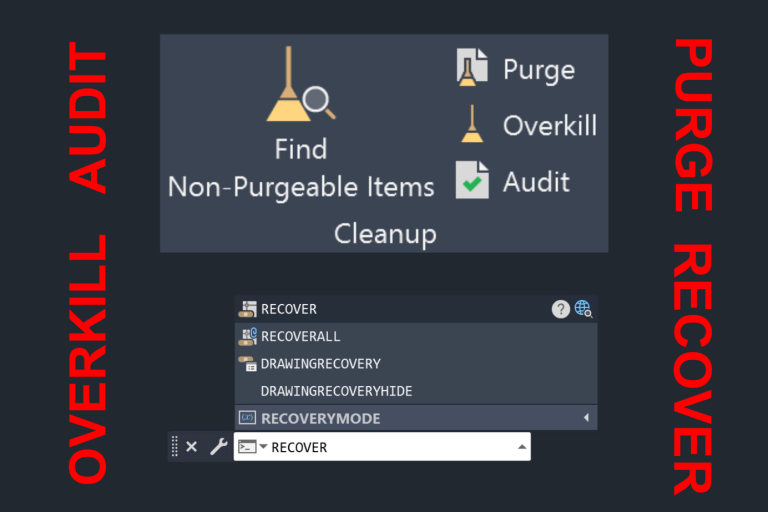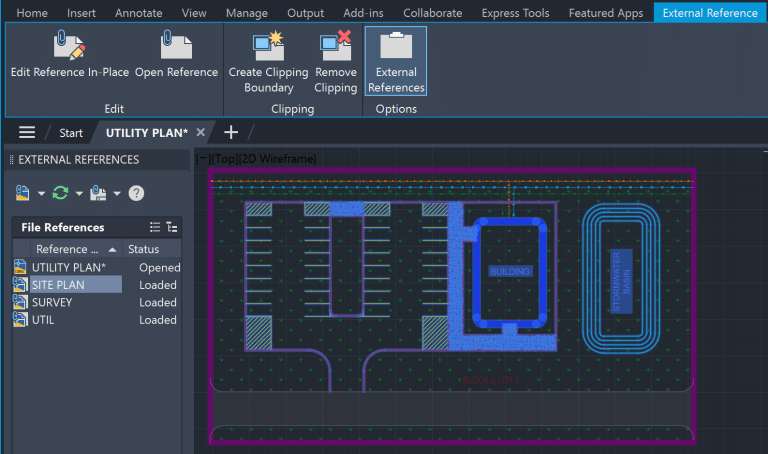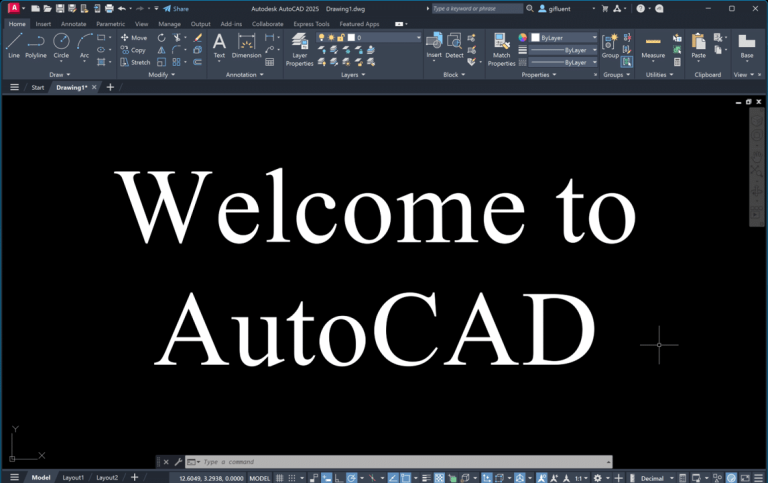13 Basic Modify Commands in AutoCAD 2025

At the heart of AutoCAD lies a powerful set of basic modify commands that transform the process of drafting from a meticulous task to an art of precision. In this blog, you will learn 13 basic modify commands, which are among the most fundamental aspects to master in AutoCAD. Some of these commands are Move, Rotate, Trim, Extend, Mirror, and Join. Let’s embark on this journey to master basic modify commands in AutoCAD.
Move
What is Move Command?
The move command is used to move an object from one place to another. There are three major ways of moving an object
- Eyeballing: Eyeball the location to which you want to move an object.
- Snaps: For better precision use snaps to move and object from one place to another
- Coordinates: If you know the exact coordinates to which you want to move an object, then type in the coordinates in the command line.
How to activate the Move Command?
Keyboard Shortcut: Type “M” in the Command Line
Menu Bar: Home > Modify > Move
Classic Example of the Move Command:
In the GIF below, we are moving an object by eyeballing, by using snaps and by using coordinates.
Rotate
What is Rotate Command?
The rotate command changes the orientation or angle of an object with a specified base point in AutoCAD. When it comes to specifying the rotation angle, there are three ways to provide the angle of rotation:
- Rotation Angle: If you know the angle at which you want to rotate an object, then simply provide that angle in the command line.
- Copy: If you want to rotate an object and keep the original object’s rotation as is, use this option.
- Reference: If you want to rotate an object based on another object’s rotation use this option.
How to activate the Rotate Command?
Keyboard Shortcut: Type “RO” in the Command Line
Menu Bar: Home > Modify > Rotate
Classic Example of the Rotate Command:
In the GIF below, we will Rotate an Object using Rotation Angle, Copy and Reference.
Trim
What is Trim Command?
The trim command is used to remove parts of an object that intersect with other objects. There are two major modes:
- Quick Mode: In this mode the objects to be deleted are selected first, and then trimmed or deleted.
- Standard Mode: In this mode, first the boundary is selected and then objects within the boundary to be trimmed are selected.
How to activate the Trim Command?
Keyboard Shortcut: Type “TR” in the Command Line
Menu Bar: Home > Modify > Trim
Classic Example of the Trim Command:
In this GIF below we explore how to trim with both Quick Mode and Standard Mode.
Extend
What is Extend Command?
The extend command is used to meet the edges of other objects. Similar to trim command, extend also has Quick Mode and Standard Mode:
- Quick Mode: In this mode first select the object and then press enter to extend the object.
- Standard Mode: In this mode, you select both the object and boundary, then press enter to extend the object.
How to activate the Extend Command?
Keyboard Shortcut: Type “EX” in the Command Line
Menu Bar: Home > Modify > Extend
Classic Example of the Extend Command:
In the GIF below, we first extend the object using standard mode and then extend the object using trim mode.
Mirror
What is Mirror Command?
The mirror command is used to create a symmetrical copy of an object by providing a specified line.
How to activate the Mirror Command?
Keyboard Shortcut: Type “MI” in the Command Line
Menu Bar: Home > Modify > Mirror
Classic Example of the Mirror Command:
In the GIF below, we are mirroring a triangle using a reference line.
Scale
What is Scale Command?
The scale command is used to enlarge or reduce the size of an object proportionately.
How to activate the Scale Command?
Keyboard Shortcut: Type “SC” in the Command Line
Menu Bar: Home > Modify > Scale
Fillet
What is Fillet Command?
The fillet command is used to create an arc or smooth transition between two non-parallel lines. If you just want to intersect two non-parallel lines at a point, choose the radius of 0. There are
How to activate the Fillet Command?
Keyboard Shortcut: Type “F” in the Command Line
Menu Bar: Home > Modify > Fillet
Chamfer
What is Chamfer Command?
The chamfer command is used to create an angled line or sloped transition between two non-parallel lies.
How to activate the Chamfer Command?
Keyboard Shortcut: Type “CHA” in the Command Line
Menu Bar: Home > Modify > Chamfer
Offset
What is Offset Command?
The offset command is used to create parallel copies of the selected objects. Its important to note that not all offsets are created equal. The system variable OFFSETGAPTYPE can be set to 0, 1 or 2, and it dictates how AutoCAD fills the created gaps at corners or intersections.
- System Variable 0 – Extends the corners
- System Variable 1 – Fillets the corners
- System Variable 2 – Chamfers the corners

How to activate the Offset Command?
Keyboard Shortcut: Type “OFFSET” in the Command Line
Menu Bar: Home > Modify > Offset
Join
What is Join Command?
The join command is used to connect lines, arcs, polylines and other One-Dimensional Drawing elements whose endpoints meets. Ensure all the objects that you want to join are on the same elevation.
How to activate the Join Command?
Keyboard Shortcut: Type “J” in the Command Line
Menu Bar: Home > Modify > Join
Explode
What is Explode Command?
The explode command breaks an object into its individual components.
How to activate the Explode Command?
Keyboard Shortcut: Type “X” in the Command Line
Menu Bar: Home > Modify > Explode
Stretch
What is Stretch Command?
The stretch command is used to stretch only part of the object selected by the selection window.
How to activate the Stretch Command?
Keyboard Shortcut: Type “STRETCH” in the Command Line
Menu Bar: Home > Modify > Stretch
Lengthen
What is Lengthen Command?
The lengthen command not only changes the length of an object but also the included angle of the arcs.
How to activate the Lengthen Command?
Keyboard Shortcut: Type “LEN” in the Command Line
Menu Bar: Home > Modify > Lengthen
Summary of Basic Modify Commands in AutoCAD
| AutoCAD Command | Purpose | Command |
| Move | Relocate an object from one place to another | M |
| Rotate | Change the orientation of an object | RO |
| Trim | Remove part of an object that intersects with other objects | TR |
| Extend | Connect an object with | EX |
| Mirror | Create a symmetrical copy of an object | MI |
| Scale | Increase or decrease size of an object with a specified factor | SC |
| Fillet | Create a curve or smooth transition between two objects | F |
| Chamfer | Create a sloped transition between two objects | CHA |
| Offset | Create parallel copies of a given object | O |
| Join | Connect lines or other one-dimensional objects whose ends meet | J |
| Explode | Break an object into individual components | X |
| Stretch | Used for stretching only part of an object | S |
| Lengthen | Changes the length of a selected object | LEN |
To learn more about other aspects of AutoCAD, feel free to checkout 25 Foundational Concepts of AutoCAD.






